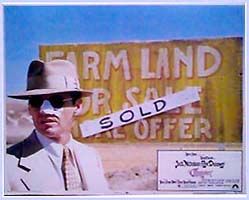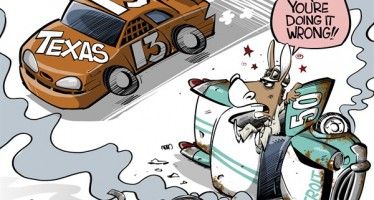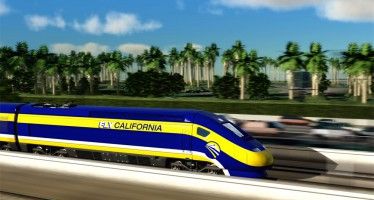Bullet train bulldozes a new ‘Chinatown’
By Wayne Lusvardi
Roman Polanski’s 1974 classic movie, “Chinatown,” was inspired by California’s water wars of almost a century ago. A modern day version of the movie seems to be playing out in California’s proposed bullet train and Delta Tunnels projects over who will get the “wealth effect” from these massive public works projects.
The real life back story to “Chinatown” was how Harry Chandler, whose family owned the Los Angeles Times until recently, used his paper to promote water bond issues for the Los Angeles Aqueduct. The water would eventually pump up land values in San Fernando Valley, where Chandler owned huge holdings.
Timothy Egan, who lives in the Pacific Northwest and writes a weekly column, “The Opinionator,” for the New York Times, thinks the modern day versions of such public works projects will restore the “California Dream.” Egan wrote in a recent column, “California Beaming,” that the proposed bullet train and Delta Tunnels projects will make California more “livable.”
Delta tunnels as a backfill operation
Egan seems to have only remote knowledge of California’s situation. First of all, re-plumbing California’s Delta water system won’t do much to meet the needs of the population growth Egan describes in California.
Sure there is population growth in California. But the rapid growth of past decades is gone. Currently there is slow and unbalanced growth. It looks like there might not be enough young, self-sufficient families to generate taxes for the one-third of all national welfare recipients who live here.
Most of the public doesn’t realize that bringing more water to Southern California through two huge tubes under the Sacramento Delta may not spur that much growth. That is because the tunnels would partly backfill water lost due to Arizona’s decision finally to take their full share of water under the Colorado River Compact.
Bullet Train as California Dreamin’
Subsidized commuter train projects are always economic losers no matter if they are local light rail projects or an intra-state commuter train between San Francisco and Los Angeles. That is because commuter rail projects are built for the positive side effects they create around transportation nodes of tourism, new commercial businesses and housing developments.
But the cost to taxpayers is large. For example, Forbes reported of Phoenix’s new light-rail system, “[T]he taxpayers must chip in $25 million of general revenue to subsidize operations, or $1,250 per daily rider per year.” It “replaced roads that can carry 6,000 trips per hour with train tracks carrying perhaps 2,200 trips per hour, not to mention adding further congestion to remaining roads when cars have to yield the right-of-way to trains.”
How about energy savings, the best selling point of rail systems? “In terms of energy use, the best source of data for analyzing light rail efficiency is annual data turned into the Department of Transportation; unfortunately, no full-year energy use data has been submitted yet for Phoenix. But we can look to other similar systems to make an educated guess. Randal O’Toole of the Cato Institute looked at energy use in a number of light rail systems, and he found the average energy use in BTU’s per passenger mile for all light rail systems to actually be above that for driving passenger cars. While trains are far more efficient than cars when full, most of the time trains do not run full, and even at rush hour half the trains (those running against the typical commute direction) are using a lot more energy to move steel than passengers.”
No one is predicting that California’s bullet train will run cars brimming with passengers.
Return of redevelopment
Local communities like light rail because it creates an increased tax base from new transit-oriented housing that circumvents the tax reassessment restrictions of Proposition 13.
For some 150 years, trains have historically spurred indirect growth in communities wherever the trains stopped. Redevelopment died in California in 2011. But it is being brought back to life in other guises such as a bullet train that supposedly rebuilds communities and reawakens the California Dream.
But a bullet train is unlikely to create housing re-development around its train stops, as has light rail. If it did, AMTRAK, which already provides long-range commuter service throughout California, would have spurred such development. A San Francisco-Los Angeles bullet train would just take jobs from commuter airplane flights between the two cities. It would be unlikely that San Jose, Fresno, Bakersfield and Palmdale would benefit from increase property tax bases due to transit-oriented real estate development.
It’s for such reasons that former state Sen. Quentin Kopp, who helped jump-start the bullet train project a decade ago, now opposes it. “They have just mangled this project,” Kopp said. “They distorted it. We don’t get a high-speed rail system. It is the great train robbery.”
So why is the bullet train going forward? To adapt a famous line from “Chinatown”: “Forget it, Jake, it’s California.”
Related Articles
Bullet train plan counting on new federal funding
The draft business report released last week by the California High-Speed Rail Authority presumes that $2.9 billion more in additional
Legitimacy, not consensus, is key to Delta modernization
May 3, 2013 By Wayne Lusvardi Do we care whether there is a consensus about what to do with the





